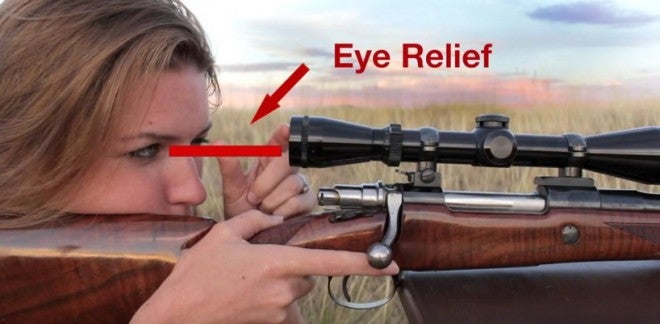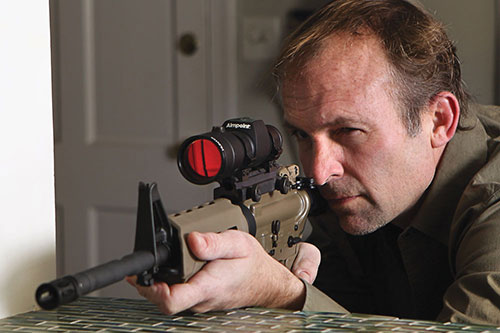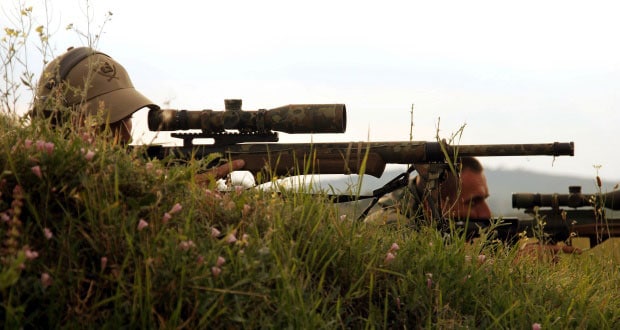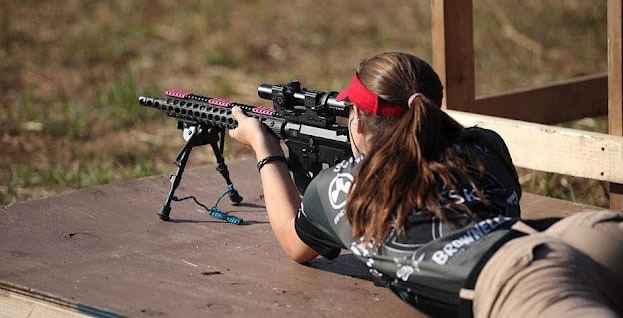Contents
First of all what is a scope. A scope is typically considered to be any type of optical aiming assistance device placed on top of a firearm. This can range from very simple affairs to very high tech options.
The invention of rifling in the fifteenth century allowed firearms to shoot more accurately at distance than ever before. A man could now reliably shoot at and expect to hit targets at ranges that were hard to see with the naked eye. So along with this ability to shoot further came the desire to see your target at longer ranges as well.
Telescopes, meanwhile, had been around for a long time by this period. Some bright individual came up with the idea of attaching a telescope to a firearm to allow you to see your target.
Following in their footsteps even brighter individuals decided to make it so you could aim with the telescope as well. This methodology of aiming with the telescope also required being able to adjust that aim for distance as well as wind drift and other factors.
Early rifle scopes were fairly primitive affairs basically like a seafarers telescope clamped onto the outside of the rifle with giant hand screws to adjust the whole telescope to move your viewpoint, and thus your aim relative to the rifle bore.
These early examples, such as the ones mounted on Civil War Era Whitworth Rifles, were usually fixed power magnification scopes which were nearly as long as the barrel of the gun. Their power was not impressive, nor was their view quality.
As time and Technology have gone on together, scopes have become greatly reduced in size while increasing in capabilities. Other types of scope have also been developed such as long eye relief and electro-optical for Red Dot sights.
1. Rifle scopes 101
Before we get too far some basic rifle scope knowledge is needed. The following are some terms you will see throughout this article. You will need to know these basic definitions of terms and what their function is.

Source : www.womensoutdoornews.com
Eyepiece
This is the part where you look through the scope and the lens that faces the shooter. This will almost always be a standard round lens though a few brands make oval or almost square ones.
It will also have a basic focus adjustment of some nature that allows the shooter to custom tailor it to their individual eyesight and focal length. Depending on the type of scope it may also have a pad or soft eyecup around the back edge. This serves to prevent hitting yourself in the eye with the scope when the gun recoils.
Adjustment turret
These are the knobs or screw heads on the outside of the scope that allow you to adjust the settings of the scope. These can range from simple flat-blade screw heads with limited adjustments to sophisticated hand wheels that are designed to be adjusted on the fly to make instant changes in where you are shooting.
The turrets allow you to change windage, which is side to side movement, and elevation which is up and down movement. Other turrets frequently found are parallax adjustment and reticle intensity when you have a light up reticle.
Objective Lens
This is the lens at the front end of the scope facing toward your target. Usually larger than your eyepiece, it is designed to let as much light in as possible. Some objectives are custom-shaped to allow you to have a larger objective that will still fit close down the barrel of the gun.
This is done by having a scallop cut into the bottom edge or by having a crescent moon shaped front objective. This is found on the larger 56mm and above objectives usually, but can be found on smaller. This lens will also typically be the one that receives any specialized coatings or filters for glare or light transmission.
Lens Coating
Lens coating first and primary purpose is to protect the lens of your scope from damage. These can range from a very simple plastic like coating or lacquer that merely protect from scratches all the way to a specialized coating which actually will protect the scope from even solar damage.
Most higher-end Scopes today will also have what is called light transmitting coatings as these are designed to allow as much light as possible to pass through the lens and into the body of the scope. Some applications actually claim to change the molecular structure of the lens in the process.
Another common function of lens coatings especially on the objective is to reduce glare on both ends. This reduces eye strain on the part of the shooter and also decreases the odds that a reflection from the scope will give away a position and spook game.
Reticle

source: en.wikipedia.org
The reticle is what differentiates a rifle scope from a spotting scope. It is a design usually made of a series of intersecting or crossing lines that allow you to use the scope to aim at your target in a repeatable fashion.
Reticles are frequently called crosshairs which is because that is what they originally were. Fine animal hairs that were placed into a frame that would keep them steady and unmoving. This frame would then be moved by adjustment screws that would bodily move the frame to move the crosshairs.
Scopes made now frequently dispense with this concept all together, using a reticle that is either etched directly onto the lens or formed as part of the internal structure of the scope. This is much more rugged and reliable under stress, as it is harder to misalign or damage by accident. It is also much easier to manufacture affordably.
Eye Relief

Source: www.thefirearmblog.com/
Eye relief, sometimes called focal length, is the distance behind the scope that you are intended to be when firing weapon. Contrary to what you see in movies most scopes are not designed to have the shooter right up against them.
The exception to this small air gun or .22 scopes with or scopes with an eyepiece which is designed to provide proper standoff. Most standard rifles have an eye relief that is between 3 and 6 inches.
Long eye relief scopes and red dots are different as they are intended to provide far more eye relief. Red dot scopes especially often have unlimited eye relief as the image doesn’t change or become unfocused as you increase your distance from the optic.
Field Of View
Field of view describes what you see when looking through the scope at your target. For example, if we said that it had a 100-yard field of view of 10 feet that would mean that when looking at a target 100 yards away the total area that you have visible in your scope is 10 feet across.
This will increase or decrease depending on range and magnification of your scope. Higher magnification scopes will have lesser fields of view typically since the prisms movement reduces the angle as the magnification increases. There are however scopes on the market that are so-called wide-angle scopes which provide larger fields of you than standard scopes of a similar size.
Parallax
Parallax refers to alignment of the prism within your scope so that your point of view is in line with your point of aim. Prisms are the internal lenses within the scope body which transmit, bend, and modify the image so that it comes out correctly at your eye.
When you adjust the magnification on a scope what you are actually doing is moving one or more of the prisms within your scope. This then creates an effect similar to using two mirrors to look at an object that's behind you with a mirror in front of you. Any misalignment in that mirror means that you will not see the object you are looking for.
Parallax adjusting refers to fixing multiple mirrors at once to align your point of view. This is done by moving them to remove any offset caused by distance between the prisms.
Fortunately not all scopes require this, some are self-adjusting in which they move the prisms internally when you adjust the magnification. As for the rest of the scopes on the market that require Parallax adjustment, most typically have an intuitive, relatively easy to use system that is marked as to what distance you are adjusting for.
Also most scopes made today only require Parallax adjustment out to a certain range, beyond that the misalignment is no longer relevant.
Scope description explained.
A scope will almost always be described by a series of numbers such as 3-9x50 or 4-16x56. These numbers might seem complicated but are very simple.
The first two numbers are the magnification range, i.e. 3-9x means that it can be adjusted from 3 times to 9 times magnification of the image. A scope with just a single number in front of the x, such as 1.4x or 4x, is a fixed power scope. These have no adjustment in magnification.
The last number is the size of the front objective., i.e. a 4-16x56 scope has an objective lens that is 56mm wide. This is one of the larger ones out there and will correspondingly let the most amount of light into the scope. These two factors when listed will give you a rough estimation of the scopes performance from just reading them.
2. Types of Rifle Scopes
Standard eye relief
Standard eye relief scopes would be pretty much any regular rifle scope you would buy from a cheap .22 caliber plinker on up to expensive target and long range scopes. These are designed to have your eye anywhere from two to six inches behind the scope. Only on very light recoiling weapons do you want to have your eyes right up against the scope. These would fit most any application for most hunters and shooters.
Long eye relief
This is usually referred to as a scout scope nowadays. It is intended our situations where your rifle may have relatively high recoil or you need to have as little scope as possible in order to make the rifle more handy and maneuverable.
Popularized in America by the esteemed gun writer Colonel Jeff Cooper, long eye relief scope have a long history in other countries. In point of fact the Germans in World War II had a variant of the Mauser k98 rifle that was configured as a sniper or designated Marksman weapon that was equipped with a long eye relief scope of relatively low magnification.
They are also used on handguns since you need to keep those away from your face while firing due to recoil, especially among the larger caliber hunting and guns. Long eye relief scopes are typically mounted in front of the action along the barrel of the gun.
Red Dot sights

Red Dot sights are an optical sight with a lens that has some sort of reticle projected onto it or lit up on it. This reticle can consist anything from a simple single dot or series of dots, to a crosshair dot and circle, all the way up to complicated ballistic reticles.
Some of the most popular models allow you to change your reticle or even its color by merely flipping a switch or pushing a button. Almost all of them allow you to change the brightness or intensity of the image depending on ambient light or target background color.
Getting into the higher-end models you find several that have dual modes of Illumination where you can use batteries or fiber optics using sunlight as another source. Higher end models even have glowing tritium gas inserts for when there is no sunlight.
This also makes these these models immune to problems like your batteries dying or other electrical issues and failures. Red dot sights tend to have very little magnification or none at all.
They are usually designed for tactical situations where too much magnification can cause you to lose situational awareness around you.
However, there is a growing number which can be had with fixed magnification or are used with the aid of a separate magnifier to allow shooting at longer distances without needing another optic.
3. Matching Your Scope To Your Purpose
Tactical

Tactical scopes, that is to say scopes being used in a tactical situation, almost entirely consist of low magnification and no magnification scopes. The reason being that while magnification of your target is very important it is also very easy to lose sight of what is going on around you while using the scope.
This can be fatal in some situations. Lower magnification and zero magnification scopes help you not lose focus as much, as they are usually designed to be used either with both eyes open or have a very wide field of view to help your situational awareness.
In a tactical situation what you don't see could very easily kill you, so it is important that optical quality of a tactical scope is perfect. This last reason is why even low magnification scopes have been losing ground to red dot sights.
These can be mounted to most any gun and give you an edge in a tactical situation by allowing faster target acquisition.
On the serious side of tactical shooting you see many militaries these days around the globe are issuing some form of low-power magnified or red dot scope to their troops.
This is because it is faster, easier, and more combat effective to teach someone to shoot with a scope. The soldier that shoots faster and more accurately lives longer.
Home Defense

Home Defense Scopes as it were mostly consist of the same scopes you would use for tactical shooting or competition at closer ranges. What is typically considered to be home defense would take place entirely inside your home or in the land directly surrounding it.
This means that you would want a scope with minimal magnification so as to not distort your target area. When you are talking home defense, situational awareness and knowing what your target is and what's beyond it are of utmost importance.
You need to be able to see exactly where you are shooting and what is surrounding it. This is so you do not hit something you can’t afford to shoot. Overwhelmingly the most popular scope for home defense is a red dot scope. These give you the best ability to get on target quickly while not compromising your awareness of the surrounding area.
It used to be that you had to worry about the batteries going out on these but newer models with battery life extending into several years have mostly laid aside that concern. That being said if you are going to be using it on your home defense weapon I would suggest not buying the cheapest option out there unless it is all you can afford.
You do not want to be trusting your life or that of a family member to something that you may not be able to trust.
If you are defending a ranch or a large piece of property then your choice might be different. In that case it might be appropriate to have a higher magnification scope to allow you to see your target at distance.
I would still consider it to be home defense to be shooting coyotes attacking your livestock in the next field. It is still appropriate to call defending your livestock home defense as they are just as much a thing to be defended as any other property or life.
Read also:
Best Thermal scopes
Best night vision Scopes
Hunting

Hunting scopes are going to be dependent on the basic factors of your hunt. Short distance brush shots call for lower magnification than hunting big horn sheep at long range.
You don’t need to have a scope that goes up to 20x magnification if your farthest out shot is only 150 yards. But if you are going to hunt prairie dogs at 1000 yards, you don’t want to use a fixed 4x scope. Not only will you not see your target, it’s just not safe to shoot like that.
So distance is your first determining Factor. Secondly, type of scope may change depending on your game animal. Coyote hunting as an example, frequently demands a scope with good light-gathering ability as well as good magnification to pick your target out among the brush he is likely to be hiding in.
Conversely, if you are hunting rabbits on foot with a handgun, you might want to invest in a good red-dot to swing on target faster. As I stated at first, this category of scope choice will be largely dependent on the basics of your hunt and where you are hunting.
Competition - Action Shooting

Competition- action shooting is typically designed to replicate combat or tactical situations for training and sport. This is where you need to have the best possible situational awareness and have the ability to get on to target as quickly as possible.
For competitive action shooting you are typically going to go with either a red dot of some nature or a lower power Scope such as a 1-4x or 1-6x power optic. These allow you to make longer shots with precision but quickly dial back to low-power for close in work.
This area of shooting is where red dots and low power optics shine as it does not require nearly as much focus to find your reticle. And once you have found it, it is easier to keep both eyes open and still concentrate on your objective without losing sight picture.
Long Range Competition

When it comes to long-range competition shooting the scope you are going to want to look for is going to be the one with the highest magnification possible for the distance. You need to be able to clearly see not only your target but everything around and beyond it.
Additionally you are going to want to have as large an objective as you can fit on your firearm. The reason for this is that you want to have as much light gathering ability as you can. This serves to brighten your target view as well as your crosshair view.
Scopes for long range shooting typically run in the 6 to 24 power magnification range. This level of magnification allows you to see your target at ranges which are beyond the ability of the naked eye. As is well-known the further the distance from an object that you are looking at the smaller the object is going to be in appearance.
After all a 6 foot tall man sized Target when placed at a distance of 1000 yards appears to be a little over 7 inches tall when viewed without the aid of a scope. This obviously means that when viewing through a scope especially a high-powered one you can thank you have more leeway on your shot in terms of missing.
Most important of all with long range shooting or even as above with longer Range Hunting your scope that you buy needs to have sufficient adjustment to be able to zero in on your target at the distance you are going to be shooting.
If your targets is far enough away you may be required to move your crosshairs to give sufficient hold over and still ensure you hit your target. For this reason you do not want to have a scope that is that is only capable of a few inches of adjustment.
While it is nice to have micro-adjustment ability as well in your optic, it current it is much more important to have basic adjustment ability and then learn to use what is so called Kentucky windage.
This is ballistic hold-over without moving any of your turrets. This is the other reason you will frequently see long-range hunters and Shooters using scopes with so-called ballistic reticles.
These allow you to make on-the-fly adjustments by merely moving the scope and rifle itself to realign with a different position or line In your reticle in regards to the Target.
This allows the shooter to keep a grip on the rifle with both hands and not disturb his position or require getting out of place to adjust the scope.
Read more:
Best scope for 308
Best 1-4x Scopes
Best Scope For Ruger 10/22
Best Pistol Scopes
Just plinking or Target Shooting

If your objective however is just a nice afternoon shooting at pop cans or steel targets at 50ft you do not need to go high tech or high magnification.
For this application it is usually sufficient to get a very simple fixed 4 power magnification scope or a no power magnification scope such as a Red Dot. This is not to say you can’t get a super zoom scope and be able to see which letter on the can you are shooting. That can be fun too, and a good way to learn all the features of a higher end scope.
4. Matching Your Scope to Your Rifle
A vitally important consideration is matching your rifle to your scope and vice versa. It does no good to buy a scope that can see further than your rifle can shoot. It also doesn't help to buy a scope that cannot see at ranges your rifle is designed to fire at.
Going with the considerations we just discussed in the four types of usage will narrow down your choices in optic. Once you have your choices narrowed down you get into more important considerations such as will this scope even fit on my rifle.
You need to ensure that your scope has the proper amount of magnification as well as light-gathering ability for the task you are going to be putting into while still fitting on your rifle.
If the scope you are looking at requires a certain amount of height above bore in order to sit correctly, you may need to adjust your planned mount and bases or even change your choice of optic. This again goes to match the technology and sophistication of your scope to your rifle.
5. Common Mistakes When Choosing The Best Rifle Scope
There are a few common mistakes made when choosing the scope for your rifle.
The first and most common one is overestimating the range you are going to be shooting at and buying more powerful of a scope than you need. Most people are not going out and shooting at a thousand yards contrary to what you see in the gun magazine.
There is no reason to have a scope for a thousand yards if your only shot is 300 yards or less. Higher-end scopes typically cost far more money than you need to spend if you are just going to be taking closer in shots.
Another common mistake that is made is buying a scope that is too complicated features wise. Learn and know in advance what you will actually need in a scope. Frequently manufacturers will make several models of scope with different features in the same model series.
Find the one that fits your needs closest, and stick with it. There is no reason for you to buy a scope with a sunshade if you are not going to need it. And if you are only shooting close in again you probably don't need a scope that auto ranges out to a thousand yards.
Also another concern along with this is that some types of shooting require that you do not have certain features on your optics. While it is fun to shoot with a scope that has a built-in a laser sights when plinking, it is also illegal to use that when hunting in most states.
Similarly if your scope is set up for distance ranging internally but you do not plan on using that feature it makes more sense to buy a less complicated and thus less costly optic.
A common pitfall among Hunters is buying a scope that is either not rugged enough or too rugged for their hunting conditions. While that nice 6-24x power scope was fantastic on the bench rest it can be a real pain to drag around through the forest. As the saying goes ounces are pounds and pounds are pain.
Nothing is worse than getting ready for that shot on a trophy animal and your arms are too tired from carrying your rifle and scope to stay steady.
6. Frequently questions answered
Here you will find a few of the more basic questions that are commonly asked about scopes and a reasonable answer without going into too much detail. For this you will want to look further back into the article.
1. What is a rifle scope?
Answer: a rifle scope is any type of optical scanning device placed on a firearm to assist in aiming.
2. What types of scope are there?
Answer: There are two main types of scope. These are fixed and variable power magnification in either long or standard eye relief. There are also what are called red dot scopes or more correctly Electro Optical sights.
3. What's the difference between a regular site and a long eye relief?
Answer: Long eye relief allows you to have your eye position further away from the weapon or increased safety from recoil and increased situational awareness.
4. What is the advantage of a red dot over a standard scope.
Answer: Red dots are designed to allow you to acquire your target faster and keep more situational awareness while shooting. Red dots have typically unlimited eye relief and can be used on almost any Firearms.
5. What kind of scope should I buy?
Answer: That is going to depend on your height of shooting a firearm distance you're going to be shooting at and innumerable other factors. This is not a question that can be answered two sentences it is going to be different for every application and shooter.
I hope that this article has been informative and useful. I hope it is given a detailed understanding of the basics of rifle scopes and their purposes.. While not intended to be an encyclopedia I hope it will serve as a reference point to help you will find the stove you are looking for or narrow down your choices at the very least.